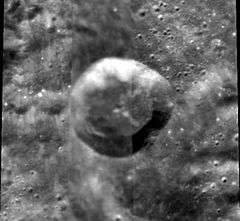Rayet (crater)
Rayet is a small lunar impact crater that lies on the far side of the Moon, past the northeast limb. It lies to the southwest of the larger crater Millikan, and east of the comparably sized Petrie.
 Clementine mosaic | |
| Coordinates | 44.7°N 114.5°E |
|---|---|
| Diameter | 27 km |
| Depth | Unknown |
| Colongitude | 246° at sunrise |
| Eponym | Georges Rayet |

Oblique Apollo 16 image

Rayet and satellite craters
This crater is roughly circular in shape, with a sharp edge and relatively featureless inner walls that slope downward to the nearly level interior floor. The diameter of the floor is roughly two-thirds that of the crater. This formation has not been notably worn by impact erosion, and is otherwise undistinguished.
This feature is named after the French astronomer Georges Rayet (1839–1906).
Satellite craters
By convention these features are identified on lunar maps by placing the letter on the side of the crater midpoint that is closest to Rayet.
| Rayet | Latitude | Longitude | Diameter |
|---|---|---|---|
| H | 43.4° N | 116.7° E | 16 km |
| P | 43.3° N | 114.0° E | 17 km |
| Y | 47.2° N | 113.0° E | 14 km |
gollark: I'm continuously amazed that people manage to control cars at 70mph on busy motorways for large periods of time with seemingly very few problematic accidents.
gollark: Your roles list doesn't say that.
gollark: So in the many worlds interpretation, do you instead get different universes where they were either funny or serious instead of them just collapsing into one state?
gollark: Samsung ones are horrendously overpriced.
gollark: M.2 is a form factor and as far as I'm aware there are no non-solid state disks in that size.
References
- Andersson, L. E.; Whitaker, E. A. (1982). NASA Catalogue of Lunar Nomenclature. NASA RP-1097.CS1 maint: ref=harv (link)
- Blue, Jennifer (July 25, 2007). "Gazetteer of Planetary Nomenclature". USGS. Retrieved 2007-08-05.CS1 maint: ref=harv (link)
- Bussey, B.; Spudis, P. (2004). The Clementine Atlas of the Moon. New York: Cambridge University Press. ISBN 978-0-521-81528-4.CS1 maint: ref=harv (link)
- Cocks, Elijah E.; Cocks, Josiah C. (1995). Who's Who on the Moon: A Biographical Dictionary of Lunar Nomenclature. Tudor Publishers. ISBN 978-0-936389-27-1.CS1 maint: ref=harv (link)
- McDowell, Jonathan (July 15, 2007). "Lunar Nomenclature". Jonathan's Space Report. Retrieved 2007-10-24.CS1 maint: ref=harv (link)
- Menzel, D. H.; Minnaert, M.; Levin, B.; Dollfus, A.; Bell, B. (1971). "Report on Lunar Nomenclature by the Working Group of Commission 17 of the IAU". Space Science Reviews. 12 (2): 136–186. Bibcode:1971SSRv...12..136M. doi:10.1007/BF00171763.CS1 maint: ref=harv (link)
- Moore, Patrick (2001). On the Moon. Sterling Publishing Co. ISBN 978-0-304-35469-6.CS1 maint: ref=harv (link)
- Price, Fred W. (1988). The Moon Observer's Handbook. Cambridge University Press. ISBN 978-0-521-33500-3.CS1 maint: ref=harv (link)
- Rükl, Antonín (1990). Atlas of the Moon. Kalmbach Books. ISBN 978-0-913135-17-4.CS1 maint: ref=harv (link)
- Webb, Rev. T. W. (1962). Celestial Objects for Common Telescopes (6th revised ed.). Dover. ISBN 978-0-486-20917-3.CS1 maint: ref=harv (link)
- Whitaker, Ewen A. (1999). Mapping and Naming the Moon. Cambridge University Press. ISBN 978-0-521-62248-6.CS1 maint: ref=harv (link)
- Wlasuk, Peter T. (2000). Observing the Moon. Springer. ISBN 978-1-85233-193-1.CS1 maint: ref=harv (link)
This article is issued from Wikipedia. The text is licensed under Creative Commons - Attribution - Sharealike. Additional terms may apply for the media files.